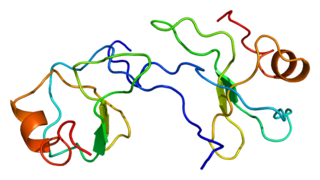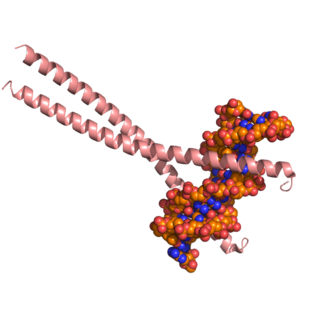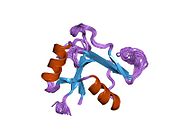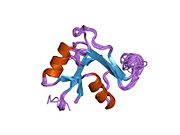
Tumor necrosis factor is an adipokine and a cytokine. TNF is a member of the TNF superfamily, which consists of various transmembrane proteins with a homologous TNF domain.
Lipoarabinomannan, also called LAM, is a glycolipid, and a virulence factor associated with Mycobacterium tuberculosis, the bacteria responsible for tuberculosis. Its primary function is to inactivate macrophages and scavenge oxidative radicals.

Chemokine ligand 3 (CCL3) also known as macrophage inflammatory protein 1-alpha (MIP-1-alpha) is a protein that in humans is encoded by the CCL3 gene.

Transcription factor Jun is a protein that in humans is encoded by the JUN gene. c-Jun, in combination with protein c-Fos, forms the AP-1 early response transcription factor. It was first identified as the Fos-binding protein p39 and only later rediscovered as the product of the JUN gene. c-jun was the first oncogenic transcription factor discovered. The proto-oncogene c-Jun is the cellular homolog of the viral oncoprotein v-jun. The viral homolog v-jun was discovered in avian sarcoma virus 17 and was named for ju-nana, the Japanese word for 17. The human JUN encodes a protein that is highly similar to the viral protein, which interacts directly with specific target DNA sequences to regulate gene expression. This gene is intronless and is mapped to 1p32-p31, a chromosomal region involved in both translocations and deletions in human malignancies.

Sphingosine kinase 1 is an enzyme that in humans is encoded by the SPHK1 gene.

Transcription factor p65 also known as nuclear factor NF-kappa-B p65 subunit is a protein that in humans is encoded by the RELA gene.

Caveolin-1 is a protein that in humans is encoded by the CAV1 gene.

CCAAT/enhancer-binding protein beta is a protein that in humans is encoded by the CEBPB gene.

TNF receptor-associated factor 5 is a protein that in humans is encoded by the TRAF5 gene.

Pentraxin-related protein PTX3 also known as TNF-inducible gene 14 protein (TSG-14) is a protein that in humans is encoded by the PTX3 gene.

Interferon regulatory factor 7, also known as IRF7, is a member of the interferon regulatory factor family of transcription factors.

TNF receptor-associated factor (TRAF3) is a protein that in humans is encoded by the TRAF3 gene.

Tumor necrosis factor, alpha-induced protein 3 or A20 is a protein that in humans is encoded by the TNFAIP3 gene.

LIGHT, also known as tumor necrosis factor superfamily member 14 (TNFSF14), is a secreted protein of the TNF superfamily. It is recognized by herpesvirus entry mediator (HVEM), as well as decoy receptor 3.

Rho guanine nucleotide exchange factor 1 is a protein that in humans is encoded by the ARHGEF1 gene. This protein is also called RhoGEF1 or p115-RhoGEF.

Mitogen-activated protein kinase kinase kinase kinase 4 (MAP4K4) – also known as hepatocyte progenitor kinase-like/germinal center kinase-like kinase (HGK) and Nck-interacting kinase (NIK) – is an enzyme, specifically a serine/threonine (S/T) kinase encoded by the MAP4K4 gene in humans.

WNT1-inducible-signaling pathway protein 1 (WISP-1), also known as CCN4, is a matricellular protein that in humans is encoded by the WISP1 gene.

Transcription factor AP-2 alpha, also known as TFAP2A, is a protein that in humans is encoded by the TFAP2A gene.

Tumor necrosis factor receptor 2 (TNFR2), also known as tumor necrosis factor receptor superfamily member 1B (TNFRSF1B) and CD120b, is one of two membrane receptors that binds tumor necrosis factor-alpha (TNFα). Like its counterpart, tumor necrosis factor receptor 1 (TNFR1), the extracellular region of TNFR2 consists of four cysteine-rich domains which allow for binding to TNFα. TNFR1 and TNFR2 possess different functions when bound to TNFα due to differences in their intracellular structures, such as TNFR2 lacking a death domain (DD).

Serpin peptidase inhibitor, clade B (ovalbumin), member 10 is a protein that in humans is encoded by the SERPINB10 gene.


























